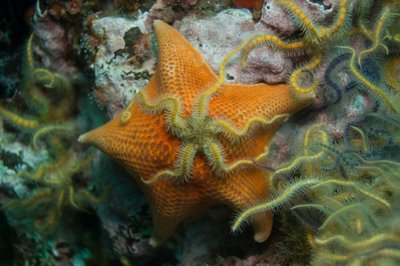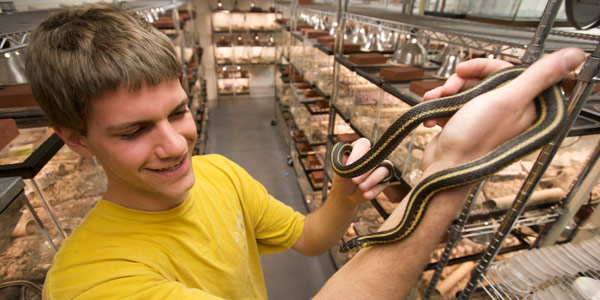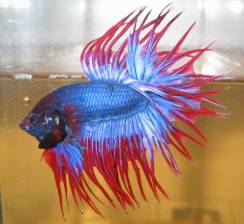These “metamaterials,” which gain their properties from their structure rather than directly from their composition, have been seen as a key to a possible “super lens” that would have an extraordinary level of resolution and be able to “see” things the size of a nanometer – a human hair is 100,000 nanometers wide.
They could also be important in machine visions systems, electronics manufacturing, computers limited only by the speed of light, and a range of new communications concepts. A “cloaking device” to hide objects, although not exactly of the type made famous by Star Trek, is also a possibility.
Breakthrough Made in Metamaterial Optics
December 5th, 2008Assessing the Threat of Whirling Disease
December 2nd, 2008Risk Assessments May Help Control Spread of Whirling Disease in rainbow trout and other salmonids:
There are no effective ways to control the disease once it’s introduced. This makes it important, researchers say, to identify the most vulnerable river systems and take all the necessary steps, including public education efforts, to prevent it from becoming established.
“Some river systems in Colorado and Montana have lost 90 percent of their rainbow trout, and because of that fishery managers take this issue very seriously,” said Jerri Bartholomew, an OSU associate professor of microbiology.
Breakthroughs in Science: Corvallis
December 2nd, 2008On October 10, 2008, the College of Science welcomed guests to the Board of Visitors Luncheon and a Breakthroughs in Science interactive faculty event. The luncheon provided our attending board members an opportunity to discuss their board “task” completed for this calendar year and our special guests a forum to discuss their history and current connection with Oregon State. Martha Coleman from the OSU Foundation and Associate Dean Vince Remcho also participated.
Using our nationally-renowned Paradigms in Physics small-group teaching method, we explored with star faculty the science and policy behind the most pressing issues of this time, like air pollution, disease, and climate change. This was a rare opportunity to sit with experts like Ethan Minot, Jane Lubchenco, Mark Hixon, Staci Simonich and Andy Blaustein to brainstorm about possible solutions, and think about how OSU could lead the way. Corinne Manogue led the discussion.
Our faculty and board members concluded the day with a brainstorming session focused on faculty-support fundraising. Guests contributed strategy suggestions for CoS’s focus on faculty support in FY10.

Above: the meeting breaks into smaller groups to discuss what data would be
needed to estimate the inflow and outflow of air pollution from the U.S.
The National System of Marine Protected Areas
December 1st, 2008From News and Communication Services at OSU:
“Marine protected areas are parts of the ocean set aside for their conservation value, much like state and national parks,” said Mark Hixon, a professor of marine biology at Oregon State University and chair of the federal advisory committee that helped produce the framework for the national system. “These are tools for the future, providing lasting protection of our living and nonliving ocean heritage for coming generations of Americans.”
“Besides benefiting fisheries, these areas will protect the rich biodiversity of the seas, the vast treasure trove of genes, organisms, species and ecosystems of the underwater world,” Hixon said. “I believe that our children and grandchildren will look back on this day with pride.”

(Photo: Jeff Lovin)
For more info:
Professional Science Masters degrees gaining national interest
November 21st, 2008Traditional science graduate degrees are usually narrow and focused on research, and traditional MBAs often possess little or no background in science. The “PSM” is seen as the perfect combination for managers who need to function in an increasingly competitive, high-tech and scientific-based business world, and in just a few years it has evolved from a curiosity to a national trend, educators say.
“This is really an exciting time for this educational concept,” said Ursula Bechert, vice president of the National Professional Science Master’s Association and director of off-campus programs for the College of Science at Oregon State University. “Graduates with this degree are increasing their employability and easily finding jobs. Both California and New York now have system-wide initiatives to develop more PSM programs. Leaders from across Oregon are meeting this week to learn more.
Read the entire media release here: Professional Science Masters degrees gaining national interest
“I love what I do”
October 30th, 2008
Co-winner of the 2008 Beaver Champion Award for outstanding effort and achievement of the highest quality, Ahern blends a zest for life with modern technology to help students overcome their fears of biochemistry and, at the same time, find their passions.
“I want them to feel hopeful,” said the Midwest native who made a conscious choice to teach and not to research when he earned his doctorate from OSU in 1986. “I work at getting them over the hump of fear and foreboding and into the lab, investigating new stuff. That’s exciting, that’s cool.”
Thou Shalt Not?
October 14th, 2008In Handle with Care, an article in the New York Times, Dr. Jane Lubchenco comments on ethics in science.
Student Success: Job One at OSU
October 13th, 2008President Ray’s quarterly report for the fall, highlighting student success, has been published online.
One of the stories in the report focuses on Dan Preston, an OSU biology major who is studying anesthetics in reptiles for his Honors College senior thesis.
For the snake study, funded in part by a Howard Hughes Medical Institute Fellowship, Preston is comparing the effectiveness of an injectable anesthetic against that of several other drugs used in veterinary medicine. Anesthesia is critical in the Mason lab, where experiments to better understand reproductive biology and physiology depend on surgical procedures. “Dr. Mason and Dr. Mosley are great mentors,” Preston says. “They let me follow the questions I find interesting and design my own experiments. And they’re available whenever I need input.”

Photo: Jim Folts
The New Spokesanimal in Town
October 11th, 2008Smokey the Bear says: Only You Can Prevent Forest Fires!
Owl says: Give a Hoot! Don’t Pollute!
Siamese Fighting Fish says: This Food Is Not Bad for You! Do Not Waste Millions of Dollars By Telling Everyone It is Bad for Them When It is Not!!
She has developed a new technology to detect illness-causing bacteria – an advance that could revolutionize the food industry, improving the actual protection to consumers while avoiding the costly waste and massive recalls of products that are suspected of bacterial contamination but are perfectly safe. Dr. Trempy’s research was just published in the journal Microbial Biotechnology.
Tiny Bubbles Continue to Tell All
October 9th, 2008OSU Media Release: Ice Core Studies Confirm Accuracy of Climate Models

This is Dr. Ed Brook holding an ancient ice core sample, which he keeps in a special freezer in the basement of Wilkinson Hall. If you’re willing to wear a special suit, we can show them to you in person some time.
The cores are precious–they hold tiny bubbles of carbon dioxide and other trace gases that are linked to climate change.
New findings cited in the media release linked above have been published in the online version of the journal Science, and are showing up in the popular media.
“We’ve identified a consistent and coherent pattern of carbon dioxide fluctuations from the past and are able to observe the correlation of this to temperature in the northern and southern hemispheres,” said Ed Brook, an associate professor of geosciences at Oregon State University. “This is a global, interconnected system of ocean and atmosphere, and data like these help us better understand how it works.”




